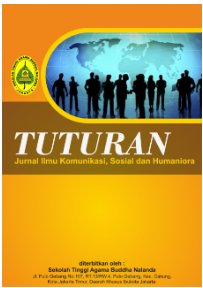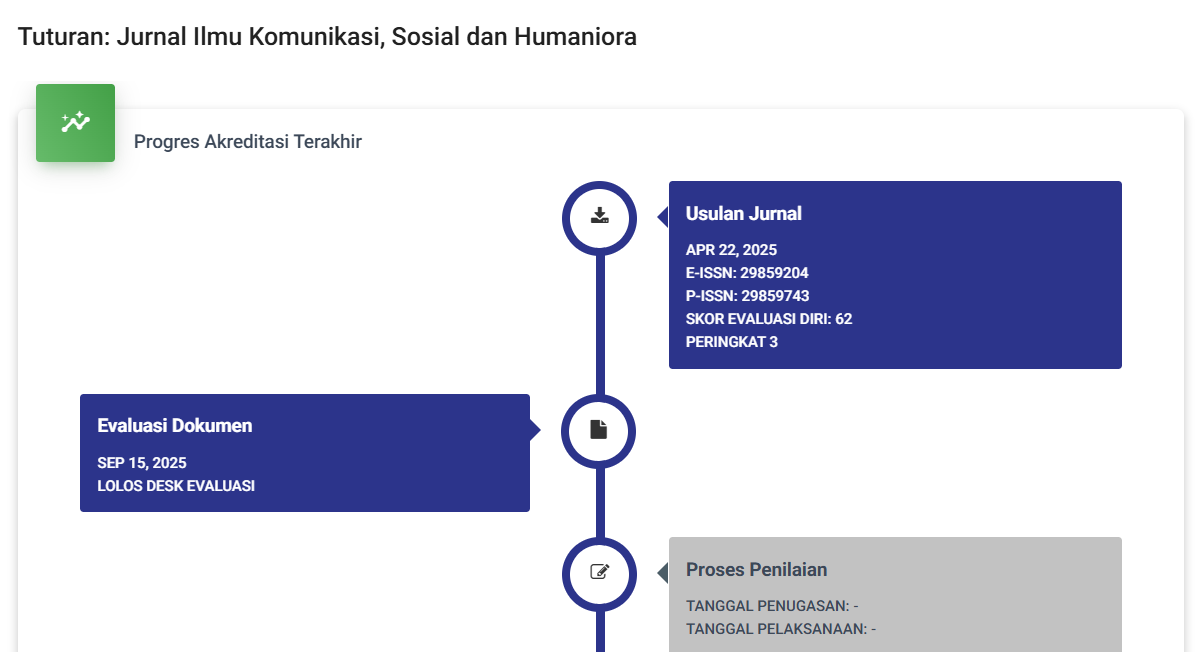Strategi Komunikasi Akun Aniesbubble di Twitter dalam Meningkatkan Engagement
DOI:
https://doi.org/10.47861/tuturan.v2i4.1194Keywords:
Communication Strategies, Non Profit Organization Message Function, Public Engagement, Quantitative Content AnalysisAbstract
In view of the increased impact of social media, non-profit organization (NPOs) should review their communication strategies in social media to manage their relation with followers. This papers aims to examine which non profit organizational type of content that enhance high public engagement in Twitter. Using a quantitative content analysis of aniesbubble, tweets during campaign election period with 78 tweets are being classified into three different message function; information-community-action. One-way ANOVA was applied to test the effects of these message function and public engagement on Twitter which is likes and retweet. Findings revealed a significant effects among non profit message function and engagement in Twitter. The findings shows that community message function achieve the highest engagement among the others.
References
Berry, J. M., & Arons, D. F. (2003). A voice for nonprofits. Brookings Institution.
Bowerman, K., & DeLorme, D. E. (2014). Boaters’ perceptions of a mobile app for a marine conservation social marketing campaign. Social Marketing Wuarterly, 20(1), 47–65.
Briones, R. L., Kuch, B., Liu, B., & Jin, Y. (2011). Keeping up with the digital age: How the American Red Cross uses social media to build relationships. Public Relations Review, 37, 37–43.
Campbell, D. A., Lambright, K. T., & Wells, C. J. (2014). Looking for Friends, Fans, and Followers? Social Media Use in Public and Nonprofit Human Services. Public Administration Review, 74(5), 655–663. https://doi.org/10.1111/puar.12261
Castillo, M., Petrie, R., & Wardell, C. (2014). Fundraising through online social networks: A field experiment on peer-to-peer solicitation. Journal of Public Economics, 114, 29–35. https://doi.org/10.1016/j.jpubeco.2014.01.002
Cho, M., Schweickart, T., & Haase, A. (2014). Public engagement with nonprofit organizations on Facebook. Public Relation Review, 40(3), 565–567.
Clark, A. F., Maxwell, S. P., & Anestaki, A. (2016). Bach, Beethoven, and benefactors: Facebook engagement between symphonies and their stakeholders. International Journal of Nonprofit and Voluntary Sector Marketing, 21(2), 96–108. https://doi.org/10.1002/nvsm.1545
DeMers, J. (2017). Why social media keeps brands accountable (and 5 key lesson for marketers). Forbes.Com.
Dhanesh, G. S. (2017). Putting engagement in its Proper place: state of the field, definition and model of engagement in public relations. Public Relations Review, 43(5), 925–933.
Forbus, R., & Synder, J. L. (2013). Use of comforting to enhance social marketing success: a case study. Social Marketing Quarterly, 19(2), 97–109.
Gálvez-Rodríguez, M. del M., Caba-Pérez, C., & López-Godoy, M. (2016). Drivers of Twitter as a strategic communication tool for non-profit organizations. Internet Research, 26(5), 1052–1071. https://doi.org/10.1108/IntR-07-2014-0188
Golbeck, J., Grimes, J. M., & Rogers, A. (2010). Twitter use by the US congress. Journal l of the American Society for Information Science and Technology, 61(8), 1612–1621.
Guidry, J. P. D., Waters, R. D., & Saxton, G. D. (2014). Moving social marketing beyond personal change to social change: Strategically using Twitter to mobilize supporters into vocal advocates. Journal of Social Marketing, 4(3), 240–260. https://doi.org/10.1108/JSOCM-02-2014-0014
Guo, C., & Saxton, G. D. (2018). Speaking and Being Heard: How Nonprofit Advocacy Organizations Gain Attention on Social Media. Nonprofit and Voluntary Sector Quarterly, 47(1), 5–26. https://doi.org/10.1177/0899764017713724
Hackler, D., & Saxton, G. D. (2007). The strategic use of information technology by nonprofit organizations: Increasing capacity and untapped potential. Public Administration Review, 67, 474–487.
Han X, Gu X, & Peng S. (2019). Analysis of Tweet form’s effect on users’ engagement on Twitter. Cog Bus Manag, 6(1), 1–15.
Haugsgjerd, A., & Karlsen, R. (2024). Election Campaigns, News Consumption Gaps, and Social Media: Equalizing Political News Use When It Matters? International Journal of Press/Politics, 29(2), 507–529. https://doi.org/10.1177/19401612221112014
Heath, R. L., Johansen, W., Hallahan, K., Steyn, B., Falkheimer, J., & Raupp, J. J. C. (2018). Strategic Communication. In The International Encyclopedia of Strategic Communication (pp. 1–24). Wiley. https://doi.org/10.1002/9781119010722.iesc0172
Holtzhausen, L., & Zerfass, A. (2015). The Routledge handbook of strategic communication. Routledge.
Hula, R. C., & Jackson-Elmoore, C. (2000). Nonprofits in urban America. CT: Quorum.
Ji, Y. G., Chen, Z. F., Tao, W., & Li, Z. C. (2019). Functional and emotional traits of corporate social media message strategies: behavioral insights from S&P 500 Facebook data. Public Relation Review, 45(1), 88–103.
Kent, M. L., Taylor, M., & White, W. J. (2003). The relationship between Web site design and organizational responsiveness to stakeholders. Public Relations Review, 29, 63–77.
Lam, W. F., & Nie, L. (2020). Online or Offline? Nonprofits’ Choice and Use of Social Media in Hong Kong. Voluntas, 31(1), 111–128. https://doi.org/10.1007/s11266-019-00128-1
León, E. de, Vermeer, S., & Trilling, D. (2023). Electoral news sharing: a study of changes in news coverage and Facebook sharing behaviour during the 2018 Mexican elections. Information, Communication & Society, 26(6), 1193–1209. https://doi.org/10.1080/1369118X.2021.1994629
LeRoux, K. (2007). Nonprofits as civic intermediaries: The role of community-based organizations in promoting political participation. Urban Affairs Review, 42(3), 410–422. https://doi.org/10.1177/1078087406292257
Lovejoy, K., & Saxton, G. D. (2012). Information, community, and action: how nonprofit organizations use social media. Journal of Computer-Mediated Communication, 17(3), 337–353.
Macias, W., Hilyard, K., & Freimuth, V. (2009). Blog functions as risk and crisis communication during Hurricane Katrina. Journal of Computer-Mediated Communication, 15, 1–31.
Men, L. R., & Tsai, W. H. S. (2014). Perceptual, attitudinal, and behavioral outcomes of organization– public engagement on corporate social networking sites. Journal of Public Relations Research, 26(5), 417–435.
Oliveira, E. (2017). The instigatory theory of NGO communication (ITNC).
Pelletier, M. J., & Horky, A. B. (2015). Exploring the Facebook Like: a product and service perspective. Journal of Research in Interactive Marketing, 9(4), 337–354.
Perez, R. A. (2001). Estrategias de comunicación.
Pettigrew, S., & Pescud, M. (2012). “Improving parents’ child-feeding practices: a social marketing challenge”. Journal of Social Marketing, 2(1), 8–22.
Qualman, E. (2013). How Social Media Transforms The Way We Live And Do Business.: Vol. Socialnomics (John Wiley & Sons, Eds.). Inc.
Riffe, D., Lacy, S., Watson, B. R., & Lovejoy, J. (2024). Analyzing Media Messages; Using Quantitative Content Analysis in Research (5th ed.). Routledge. https://doi.org/10.4324/9781003288428
Roehm, H. A., & Haugtvedt, C. P. (199 C.E.). Understanding Interactivity of Cyberspace Advertising (1st edition).
Rybalko, S., & Seltzer, T. (2010). Dialogic communication in 140 characters or less: how Fortune 500 companies engage stakeholders using Twitter. Public Relations Review, 36(4), 336–341.
Saxton, G. D., & Guo, C. (2011). Accountability Online: Understanding the Web-Based Accountability Practices of Nonprofit Organizations. Nonprofit and Voluntary Sector Quarterly, 40(2), 270–295. https://doi.org/10.1177/0899764009341086
Saxton, G. D., & Wang, L. (2014). The Social Network Effect. Nonprofit and Voluntary Sector Quarterly, 43(5), 850–868. https://doi.org/10.1177/0899764013485159
Strömbäck, J., & Kaid L. L. (2008). The Handbook of Election News Coverage Around the World. Routledge.
Svensson, P. G., Mahoney, T. Q., & Hambrick, M. E. (2015). Twitter as a Communication Tool for Nonprofits. Nonprofit and Voluntary Sector Quarterly, 44(6), 1086–1106. https://doi.org/10.1177/0899764014553639
van Aelst, P., Thorbjørnsrud, K., & Aalberg, T. (2012). The Political Information Environment During Election Campaigns (T. Aalberg & J. Curran, Eds.). Routledge.
Waters, R. D. (2007). Nonprofit organizations’ use of the internet: A content analysis of communication trends on the internet sites of the philanthropy 400. Nonprofit Management and Leadership, 18(1), 59–67.
Waters, R. D., Burnett, E., Lamm, A., & Lucas, J. (2009). Engaging stakeholders through social networking: How nonprofit organizations are using Facebook. Public Relations Review, 35(2), 102–106. https://doi.org/10.1016/j.pubrev.2009.01.006
Waters, R. D., & Jamal, J. Y. (2011). Tweet, tweet, tweet: A content analysis of nonprofit organizations’ Twitter updates. Public Relations Review, 37(3), 321–324. https://doi.org/10.1016/j.pubrev.2011.03.002
Watkins, B., & Lewis, R. (2014). Initiating dialogue on social media: an investigation of athletes’ use of dialogic principles and structural features of Twitter. Public Relations Review , 40, 853–855.
Weick, K. E. (1995). Sensemaking in organizations.
Yilmaz, İ. G., Aygün, D., & Tanrikulu, Z. (2017). Social Media’s Perspective on Industry 4.0: A Twitter Analysis. Social Networking, 06(04), 251–261. https://doi.org/10.4236/sn.2017.64017
Zhang, Y., Dong, C., & Cheng, Y. (2023). How do nonprofit organizations (NPOs) effectively engage with the public on social media? Examining the effects of interactivity and emotion on Twitter. Internet Research, 33(2), 550–577. https://doi.org/10.1108/INTR-05-2021-0290
Zhong, Z., & Lin, S. (2018). The antecedents and consequences of charitable donation heterogeneity on social media. International Journal of Nonprofit and Voluntary Sector Marketing, 23(1). https://doi.org/10.1002/nvsm.1585
Downloads
Published
How to Cite
Issue
Section
License
Copyright (c) 2024 TUTURAN: Jurnal Ilmu Komunikasi, Sosial dan Humaniora

This work is licensed under a Creative Commons Attribution 4.0 International License.








